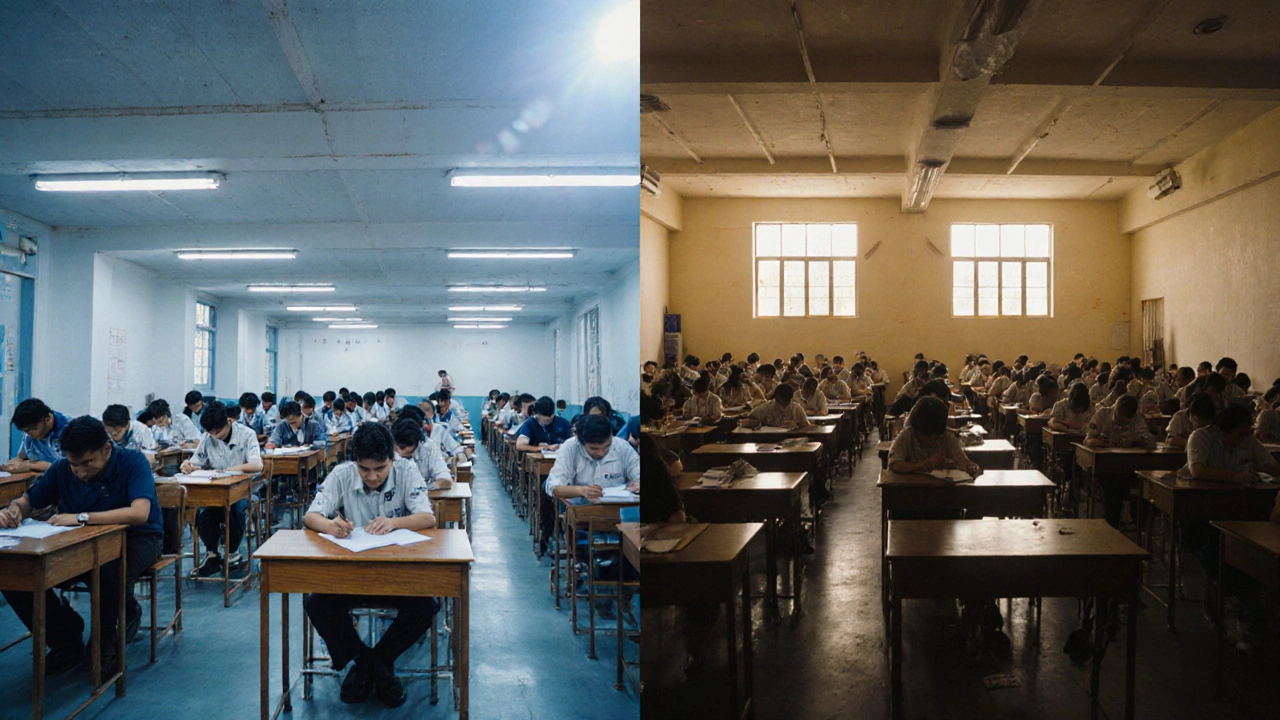
Government Job Competition Calculator
Calculate Your Government Job Competition Ratio
Enter the number of applicants and vacancies to calculate the competition ratio. A ratio below 250 is typically considered low competition.
When you start hunting for a least competitive government jobs opportunity, the first question is: does a truly low‑competition post exist? The answer is yes, but you need to know where to look, how the numbers are calculated, and what trade‑offs come with a job that attracts fewer candidates.
What "competition" Really Means in the Government‑Job World
Competition is usually expressed as applicants per vacancy. A post with 10,000 applicants for 5 seats has a ratio of 2,000, while a vacancy with 500 applicants for 4 seats sits at 125. The lower the ratio, the easier it is to clear the written exam and the subsequent interview.
Factors that shape the ratio include:
- Geographic location - remote districts see fewer aspirants.
- Job profile - clerical or non‑technical roles often attract mass applications, whereas niche technical posts get a smaller pool.
- Salary and perks - well‑paying services like the Indian Administrative Service (IAS) draw massive crowds, while modest pay grades draw fewer.
Understanding these drivers helps you target posts where the odds are in your favour.
Key Sources to Gauge Competition
Reliable data comes from official recruiting bodies. The Staff Selection Commission (SSC) conducts exams for a wide range of clerical, statistical and technical posts across the country., the Railway Recruitment Board (RRB) handles railway‑related vacancies, many of which are location‑specific and see limited competition., and the Defence Research and Development Organisation (DRDO) runs niche scientific posts that require specialized degrees, keeping applicant numbers low. Keep an eye on annual reports, official admit‑card statistics, and post‑exam cut‑off trends published on these agencies’ websites.
Top Low‑Competition Government Jobs in 2025
| Post | Recruiting Agency | Vacancies | Avg. Applicants per Vacancy | Pay Scale (Level) | Eligibility |
|---|---|---|---|---|---|
| Assistant Engineer (Civil) - Rural Projects | Public Works Department (PWD) | 120 | 180 | Level 10 | B.E./B.Tech in Civil |
| Junior Statistical Officer | Staff Selection Commission (SSC) | 85 | 220 | Level 11 | B.A. / B.Sc. (Stat) |
| Technician - Defence Research Lab | Defence Research and Development Organisation (DRDO) | 60 | 150 | Level 9 | Diploma in Electronics/IT |
| Clerk - Rural Development Officer | State Government - Maharashtra | 70 | 130 | Level 8 | Graduate (any stream) |
| Postal Assistant - Remote Branches | Indian Postal Service | d>95110 | Level 8 | Graduate (any stream) |
The table highlights posts that consistently register fewer than 250 applicants per vacancy. While salaries are modest compared with premier services, the entry barrier is lower, making them attractive for candidates with a clear focus on speed to job.

How to Verify Current Competition Levels
Data from 2024‑2025 shows a gradual shift: some traditionally crowded posts have seen a dip because aspirants are moving toward private‑sector tech jobs. To stay updated:
- Visit the official recruitment portal (e.g., ssc.in for SSC, drdo.gov.in for DRDO).
- Download the latest “Vacancy & Applicant Statistics” PDF.
- Calculate the ratio yourself: total applicants ÷ total vacancies.
- Cross‑check cut‑off marks. A lower cut‑off often signals fewer competitors.
If a post lacks published numbers, use Google Trends to gauge search interest around the exam name. Lower search volume typically correlates with less competition.
Preparation Blueprint for Low‑Competition Posts
Even when the applicant pool is small, the exam still tests core concepts. Follow this streamlined plan:
- Identify the syllabus early: Most low‑competition posts use the General Studies or technical basics syllabus, which you can download from the recruiting agency’s site.
- Allocate 2‑3 weeks for each major subject. For technical posts, focus on the specific engineering or diploma topics that appear most often.
- Practice with the last three years’ question papers. Because the number of candidates is lower, the pattern remains stable.
- Take a full‑length mock every two weeks. Review mistakes immediately; the limited competition means a small mistake can cost a rank.
- Prepare a concise formula sheet. In low‑volume exams, interview panels often probe deeper on the few topics you highlighted.
Time investment is less than for high‑competition exams, freeing you up for part‑time work or upskilling.
Pros and Cons of Choosing a Low‑Competition Job
Advantages
- Quicker selection timeline - many agencies announce results within 2 months.
- Higher probability of securing a secure, government‑backed salary.
- Clear career ladder; promotions follow a standard seniority rule.
Potential drawbacks
- Salary may be modest compared with higher‑profile services.
- Posting locations can be remote or in less‑developed districts.
- Growth opportunities sometimes require additional qualifications or departmental transfers.
Weigh these factors against your personal priorities - location preference, financial goals, and willingness to pursue further studies.

Quick Checklist Before Applying
- Confirm the latest vacancy notification on the official website.
- Calculate the current applicant‑to‑vacancy ratio (if available).
- Verify eligibility - degree, age limit, and any physical standards.
- Gather required documents: mark sheets, caste certificate (if applicable), and domicile proof.
- Register on the portal before the deadline; late entries are automatically rejected.
- Schedule a mock test at least 30 days before the official exam date.
Cross‑checking these items reduces last‑minute stress and gives you confidence on exam day.
Where to Find the Latest Updates in 2025
Official sources are the safest bet, but a few reliable aggregators keep track of low‑competition posts:
- Government Jobs Portal India (GovtJobsPortal.in) offers a filtered view for posts with applicant ratios below 200.
- Exam Alerts India (ExamAlerts.in) sends email alerts when a vacancy with limited competition is released.
- Follow the official Twitter handles of SSC, RRB, and DRDO - they announce new posts in real time.
Bookmark these pages and set a weekly reminder. Consistency beats luck when you’re hunting for a niche government role.
Final Thoughts
Targeting a post with low competition doesn’t guarantee instant success, but it dramatically improves your odds compared with marquee services like IAS or IPS. By staying data‑driven, choosing the right syllabus, and following a focused preparation plan, you can secure a stable government position without the marathon of endless mock tests.
Which government job currently has the lowest applicant‑to‑vacancy ratio?
In 2025, the Postal Assistant posts in remote branches of the Indian Postal Service consistently show a ratio around 110 applicants per vacancy, making them the least competitive among mainstream government jobs.
Do low‑competition jobs offer good career growth?
Yes. Most government services follow a clear pay‑band progression based on seniority and performance. While the starting salary may be modest, promotions and lateral transfers can lead to higher grades over time.
How can I find the exact number of applicants for a vacancy?
Official recruiting agencies publish a “Vacancy & Applicant Statistics” PDF after the application window closes. Download it from the agency’s website and divide the total applicant count by the number of vacancies.
Are there any hidden costs when applying for these jobs?
Most applications are free, but you may need to pay for a certified copy of your degree, a photograph, or a courier fee for document verification, depending on the agency’s guidelines.
What preparation resources are best for low‑competition technical posts?
Focus on the specific technical syllabus issued by the recruiting body. Use the last three years’ question papers, the official “Technical Handbook” provided on the portal, and concise formula sheets prepared from standard engineering textbooks.





